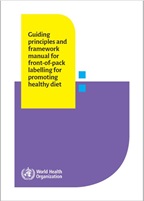CFS Voluntary Guidelines on Food Systems and Nutrition
The Committee on World Food Security (CFS) adopted the Voluntary Guidelines on Food Systems and Nutrition (VGFSyN) at its 47th Plenary session in February 2021. The VGFSyN are an inter-governmental and multi-stakeholder negotiated policy tool for use by governments, and their partners to develop appropriate policies, investments and institutional arrangements to address the causes of hunger and malnutrition in all its forms, from a food systems perspective.
The Voluntary Guidelines present a wide range of recommendations to promote policy coherence and reduce policy fragmentation between relevant sectors, including - agriculture, health, and environment - all of which impact and are impacted by food systems. They aim to support the development of coordinated, multi-sectoral national policies, laws, programmes and investment plans to enable safe and healthy diets through sustainable food systems.
The Voluntary Guidelines are a contribution to the UN Decade of Action on Nutrition (2016-2025) and intend to help countries to further operationalize recommendations of the Framework for Action agreed at the Second International Conference on Nutrition (ICN2) held in 2014.
Q&A: CFS Voluntary Guidelines on Food Systems and Nutrition
Data
Guidance and guideline
Guidelines on specific nutrient intake
Saturated fatty acids and trans-fatty acids and total fat intake
- Diet, nutrition and the prevention of chronic diseases. Report of a joint WHO/FAO expert consultation. WHO Technical Report Series 916
- Updated, draft guidelines for saturated fatty acids and trans-fatty acids have been issued for public comment and are currently being finalized
- Updated, draft guideline for total fat intake is currently available for public comment at:
https://www.who.int/news-room/articles-detail/call-for-comments-on-the-draft-guideline-total-fat-intake-for-adults-and-children
Protecting children from the harmful impact of food marketing (0-18 years of age)
Fiscal policies (subsidies and taxation)
Nutrition labelling

Guiding principles and framework manual for front-of-pack labelling for promoting healthy diets
Front-of-pack labelling (FOPL) is an important policy tool for countries to help consumers to make healthier food choices. This document – WHO guiding...
Public food procurement and service
Action framework for developing and implementing public food procurement and service policies for a healthy...
This action framework provides an overview of how to develop (or strengthen), implement, assess compliance with, and evaluate, the effectiveness of...
Food fortification
Guideline: fortification of rice with vitamins and minerals as a public health strategy
WHO guideline: use of multiple micronutrient powders for point-of-use fortification of foods consumed by infants and young children aged 6–23 months and children aged 2–12 years
Fortification of maize flour and corn meal with vitamins and minerals
Guideline: use of multiple micronutrient powders for point-of-use fortification of foods consumed by pregnant women
Guideline: fortification of food-grade salt with iodine for the prevention and control of iodine deficiency disorders
Guidelines on food fortification with micronutrients
Resolutions
WHA65.6 Comprehensive implementation plan on maternal, infant and young child nutrition.
WHA66.10 Global action plan for the prevention and control of noncommunicable diseases 2013–2020.
WHA57.17 Global strategy on diet, physical activity and health
A/RES/70/259 - UN 2016. United Nations Decade of Action on Nutrition (2016–2025)

